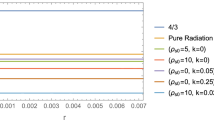Abstract
We analyse a new family of solutions to the Einstein field equations describing the collapse of a fluid sphere in the presence of heat flux and shear. These solutions ensure that the collapsing fluid is accelerating and provide a generalisation of the geodesic fluid models studied in earlier treatments. In particular, we demonstrate the role played by pressure in the dynamics of the collapse process.




Similar content being viewed by others
References
Hawking, S., Penrose, R.: The Nature of Space and Time. Princeton University Press, Princeton (1996)
Oppenheimer, J.R., Snyder, H.: On continued gravitational contraction. Phys. Rev. D 56, 455 (1939)
Santos, N.O.: Non-adiabatic radiating collapse. Mon. Not. R. Astron. Soc. 216, 403 (1985)
Banerjee, A., Chatterjee, S., Dadhich, N.: Spherical collapse with heat flow and without horizon. Mod. Phys. Lett. A 35, 2335 (2002)
Naidu, N.F., Govender, M., Govinder, K.S.: Thermal evolution of a radiating anisotropic star with shear. Int. J. Mod. Phys. D 15, 1053 (2006)
Govender, M., Thirukkanesh, S.: Dissipative collapse in the presence of Λ. Int. J. Theor. Phys. 48, 3558 (2009)
Rajah, S.S., Maharaj, S.D.: A Riccati equation in radiative stellar collapse. J. Math. Phys. 49, 012501 (2008)
Herrera, L., Santos, N.O.: Collapsing spheres satisfying an “Euclidean condition”. Gen. Relativ. Gravit. 42, 2383 (2010)
Vaidya, P.C.: The gravitational field of a radiating star. Proc. Indian Acad. Sci., Sect. A, Phys. Sci. 33, 264 (1951)
Govender, G., Govender, M., Govinder, K.S.: Thermal behaviour of Euclidean stars. Int. J. Mod. Phys. D 19, 1773 (2010)
Di Prisco, A., Herrera, L., Ospino, J., Santos, N.O., Viña-Cervantes, V.M.: Expansion-free cavity evolution: some exact analytical models. Int. J. Mod. Phys. D 20, 2351 (2011)
Thirukkanesh, S., Rajah, S.S., Maharaj, S.D.: Shearing radiative collapse with expansion and acceleration. J. Math. Phys. 53, 032506 (2012)
Fleming, D.: Dissipative gravitating systems. Unpublished MSc Thesis, UKZN, South Africa (2012)
Govinder, K.S., Govender, M.: A general class of Euclidean stars. Gen. Relativ. Gravit. 44, 147 (2012)
Maartens, R.: Causal thermodynamics in relativity (1996). arXiv:astro-ph/9609119v1
Author information
Authors and Affiliations
Corresponding author
Rights and permissions
About this article
Cite this article
Govender, M., Govinder, K.S. & Fleming, D. The Role of Pressure During Shearing, Dissipative Collapse. Int J Theor Phys 51, 3399–3409 (2012). https://doi.org/10.1007/s10773-012-1221-8
Received:
Accepted:
Published:
Issue Date:
DOI: https://doi.org/10.1007/s10773-012-1221-8



